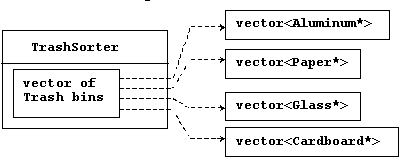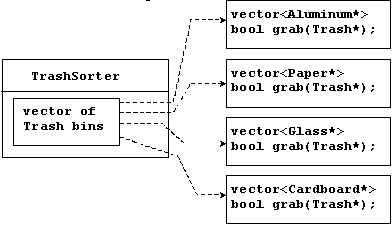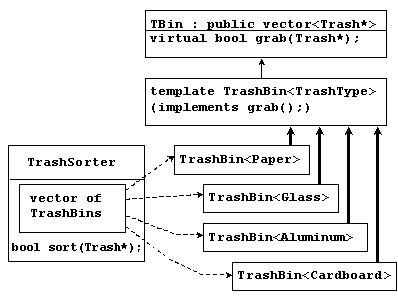//: C25:Recycle4.cpp
//{L} TrashPrototypeInit
//{L} fillBin Trash TrashStatics
// Adding TrashBins and TrashSorters
#include "Trash.h"
#include "Aluminum.h"
#include "Paper.h"
#include "Glass.h"
#include "Cardboard.h"
#include "fillBin.h"
#include "sumValue.h"
#include "../purge.h"
#include <fstream>
#include <vector>
using namespace std;
ofstream out("Recycle4.out");
class TBin : public vector<Trash*> {
public:
virtual bool grab(Trash*) = 0;
};
template<class TrashType>
class TrashBin : public TBin {
public:
bool grab(Trash* t) {
TrashType* tp = dynamic_cast<TrashType*>(t);
if(!tp) return false; // Not grabbed
push_back(tp);
return true; // Object grabbed
}
};
class TrashSorter : public vector<TBin*> {
public:
bool sort(Trash* t) {
for(iterator it = begin(); it != end(); it++)
if((*it)->grab(t))
return true;
return false;
}
void sortBin(vector<Trash*>& bin) {
vector<Trash*>::iterator it;
for(it = bin.begin(); it != bin.end(); it++)
if(!sort(*it))
cerr << "bin not found" << endl;
}
~TrashSorter() { purge(*this); }
};
int main() {
vector<Trash*> bin;
// Fill up the Trash bin:
fillBin("Trash.dat", bin);
TrashSorter tbins;
tbins.push_back(new TrashBin<Aluminum>());
tbins.push_back(new TrashBin<Paper>());
tbins.push_back(new TrashBin<Glass>());
tbins.push_back(new TrashBin<Cardboard>());
tbins.sortBin(bin);
for(TrashSorter::iterator it = tbins.begin();
it != tbins.end(); it++)
sumValue(**it);
sumValue(bin);
purge(bin);


